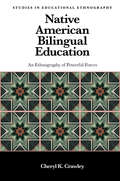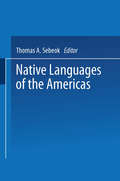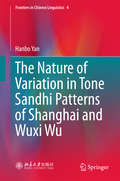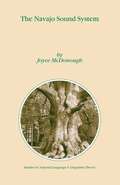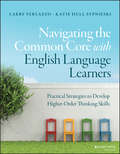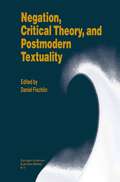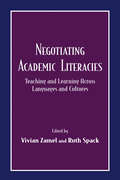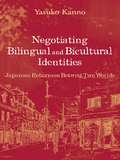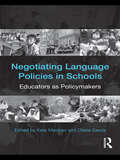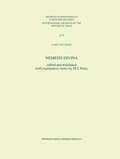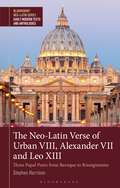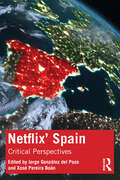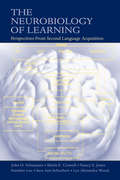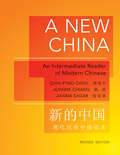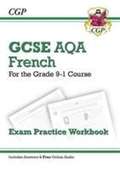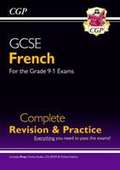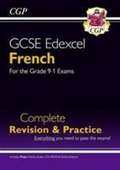- Table View
- List View
Native American Bilingual Education: An Ethnography of Powerful Forces (Studies in Educational Ethnography)
by Dr Cheryl K. CrawleyFor over thirty years, a political and social battle over bilingual education raged in the U.S. and in and around the Crow Indian Reservation of Montana. This book, a period piece rich in political, historical, and local western context, is the story of language, education, inequality and power clashes between the dominant society and the Indian tribe as historical events unfolded. This is a classic ethnography that documents eight years of the author’s day-to-day experience as a teacher, bilingual education coordinator, and central office administrator during the socio-political dispute. The author showcases the familial, linguistic, and ancestral place-based strengths of the Crow families that empowered children to succeed in school against the odds, providing a secure foundation for their future leadership within the tribe. In doing this, the author builds strong support for bridging Native and Euro-American philosophies within a bilingual framework. This book is important reading for teachers, administrators, and policy-makers. It provides hope, ideas, and concrete actions for those who would engage in change management to improve learning environments and better serve diverse students.
Native American Bilingual Education: An Ethnography of Powerful Forces (Studies in Educational Ethnography)
by Dr Cheryl K. CrawleyFor over thirty years, a political and social battle over bilingual education raged in the U.S. and in and around the Crow Indian Reservation of Montana. This book, a period piece rich in political, historical, and local western context, is the story of language, education, inequality and power clashes between the dominant society and the Indian tribe as historical events unfolded. This is a classic ethnography that documents eight years of the author’s day-to-day experience as a teacher, bilingual education coordinator, and central office administrator during the socio-political dispute. The author showcases the familial, linguistic, and ancestral place-based strengths of the Crow families that empowered children to succeed in school against the odds, providing a secure foundation for their future leadership within the tribe. In doing this, the author builds strong support for bridging Native and Euro-American philosophies within a bilingual framework. This book is important reading for teachers, administrators, and policy-makers. It provides hope, ideas, and concrete actions for those who would engage in change management to improve learning environments and better serve diverse students.
Native Languages of the Americas: Volume 1
by Thomas SebeokThirteen of the chapters that comprise the contents of this first volume of Native Languages of the A mericas were originally commissioned by the undersigned in his capacity as Editor of the fourteen volume series (1963-1976), Current Trends in Linguistics. All appeared, in 1973, under Part Three of the quadripartite Vol. 10, subtitled Linguistics in North America. Two additional chaplers are being held over for the volume to follow shortly, devoted to Central and South American lan guages and linguistics, where they more appropriately belong. A fourteenth chapter, on the" Historiography of native North A merican linguistics," was written similarly by invitation, for Vol. 13, subtitled Historiography of Linguistics, published in 1975. Both Volumes 10 and 13 were jointly financed by the United States National Science Foundation and National Endowment for the Humanities, with an enhancing contribution to the former by the Canada Council. The generosity of these funding agencies was, of course, previously acknowledged in my respective Editor's Introductions to the two books mentioned, but cannot be repeated too often: without their welcome and timely assistance, the global project could scarcely have been realized on so comprehensive a scale. The Current Trends in Linguistics series was a long-term venture of Mouton Publishers, of The Hague, under the imaginative in-house direction of Peter de Rid der. Various spin-offs were foreseen, and some of them happily realized.
The Nature of Variation in Tone Sandhi Patterns of Shanghai and Wuxi Wu (Frontiers in Chinese Linguistics #4)
by Hanbo YanThis book conducts a thorough investigation of the variation in tone sandhi patterns of Shanghai and Wuxi Wu using quantitative rating experiments. Although Shanghai Wu has been well documented, to date there has never been any quantitative study that systematically investigates the factors that influence variability – a research gap this book fills. Further, Wuxi Wu is investigated as an additional case that demonstrates the unique phonological nature of tone sandhi, and how it changes how speakers learn and internalize the variable tone sandhi pattern. The findings presented here will shed new light on important issues of wordhood, the interface of morphosyntax and phonology, and the formal model of variability in phonology.
The Navajo Sound System (Studies in Natural Language and Linguistic Theory #55)
by J.M. McDonoughThe Navajo language is spoken by the Navajo people who live in the Navajo Nation, located in Arizona and New Mexico in the southwestern United States. The Navajo language belongs to the Southern, or Apachean, branch of the Athabaskan language family. Athabaskan languages are closely related by their shared morphological structure; these languages have a productive and extensive inflectional morphology. The Northern Athabaskan languages are primarily spoken by people indigenous to the sub-artic stretches of North America. Related Apachean languages are the Athabaskan languages of the Southwest: Chiricahua, Jicarilla, White Mountain and Mescalero Apache. While many other languages, like English, have benefited from decades of research on their sound and speech systems, instrumental analyses of indigenous languages are relatively rare. There is a great deal ofwork to do before a chapter on the acoustics of Navajo comparable to the standard acoustic description of English can be produced. The kind of detailed phonetic description required, for instance, to synthesize natural sounding speech, or to provide a background for clinical studies in a language is well beyond the scope of a single study, but it is necessary to begin this greater work with a fundamental description of the sounds and supra-segmental structure of the language. Inkeeping with this, the goal of this project is to provide a baseline description of the phonetic structure of Navajo, as it is spoken on the Navajo reservation today, to provide a foundation for further work on the language.
Navigating the Common Core with English Language Learners: Practical Strategies to Develop Higher-Order Thinking Skills (J-B Ed: Survival Guides)
by Larry Ferlazzo Katie Hull SypnieskiThe must-have Common Core guide for every ESL/ELL instructor Navigating the Common Core with English Language Learners is the much-needed practical guide for ESL/ELL instructors. Written by experienced teachers of English Language Learners, this book provides a sequel to the highly-regarded ESL/ELL Teacher's Survival Guide and is designed to help teachers implement the Common Core in the ELL classroom. You'll find a digest of the latest research and developments in ELL education, along with comprehensive guidance in reading and writing, social studies, math, science, Social Emotional Learning and more. The Common Core is discussed in the context of ESL, including the opportunities and challenges specific to ELL students. Ready-to-use lesson plans and reproducible handouts help you bring these ideas into the classroom, and expert guidance helps you instill the higher-order thinking skills the Common Core requires. The Common Core standards have been adopted in 43 states, yet minimal guidance has been provided for teachers of English Language Learners. This book fills the literature gap with the most up-to-date theory and a host of practical implementation tools. Get up to date on the latest stats and trends in ELL education Examine the challenges and opportunities posed by Common Core Find solutions to common issues that arise in teaching ELL students Streamline Common Core implementation in the ELL classroom The ELL population is growing at a rapid pace, and the ELL classroom is not exempt from the requirements posed by the Common Core State Standards. ESL/ELL teachers know better than anyone else how critical language is to learning, and ELL students need a specialized Common Core approach to avoid falling behind. Navigating the Common Core with English Language Learners provides specific guidance and helpful tools that teachers can bring to the classroom today.
Navigating the Common Core with English Language Learners: Practical Strategies to Develop Higher-Order Thinking Skills (J-B Ed: Survival Guides)
by Larry Ferlazzo Katie Hull SypnieskiThe must-have Common Core guide for every ESL/ELL instructor Navigating the Common Core with English Language Learners is the much-needed practical guide for ESL/ELL instructors. Written by experienced teachers of English Language Learners, this book provides a sequel to the highly-regarded ESL/ELL Teacher's Survival Guide and is designed to help teachers implement the Common Core in the ELL classroom. You'll find a digest of the latest research and developments in ELL education, along with comprehensive guidance in reading and writing, social studies, math, science, Social Emotional Learning and more. The Common Core is discussed in the context of ESL, including the opportunities and challenges specific to ELL students. Ready-to-use lesson plans and reproducible handouts help you bring these ideas into the classroom, and expert guidance helps you instill the higher-order thinking skills the Common Core requires. The Common Core standards have been adopted in 43 states, yet minimal guidance has been provided for teachers of English Language Learners. This book fills the literature gap with the most up-to-date theory and a host of practical implementation tools. Get up to date on the latest stats and trends in ELL education Examine the challenges and opportunities posed by Common Core Find solutions to common issues that arise in teaching ELL students Streamline Common Core implementation in the ELL classroom The ELL population is growing at a rapid pace, and the ELL classroom is not exempt from the requirements posed by the Common Core State Standards. ESL/ELL teachers know better than anyone else how critical language is to learning, and ELL students need a specialized Common Core approach to avoid falling behind. Navigating the Common Core with English Language Learners provides specific guidance and helpful tools that teachers can bring to the classroom today.
Negation, Critical Theory, and Postmodern Textuality
by Daniel FischlinNegation, Critical Theory, and Postmodern Textuality features 14 new essays by leading specialists in critical theory, comparative literature, philosophy, and English literature. The essays, which present wide-ranging historical considerations of negation in light of recent developments in poststructuralism and postmodernism, range over many of the siginificant texts in which negation figures prominently. The book includes a wide-ranging introductory chapter that examines how attention to negation -- the inescapable nescience that is posited in any and every linguistic expression -- enhances the hermeneutic possibilities present in language. In addition, the four sections of the book bring together major critical interventions on, among others, negative meaning, unrecognizability, elenctic negation, apocalypse, nihilism, negation and gender, and denegation. All the essays involve close attention to key texts by major authors, including William Shakespeare, Henry James, Federico García Lorca, Samuel Beckett, Thomas Bernhard, Walt Whitman, E.M. Forster, Mary Shelley, Margaret Atwood, Roland Barthes, Douglas Barbour, Paul de Man, bp Nichol, Jacques Derrida, and Dogen Kigen. The volume opens up new areas in critical theory, comparative literature, and the philosophy of language, and defines a major new area of inquiry in relation to notions of postmodern textuality. Critical theorists, students of comparative literature, English literature, and the history of ideas, and those interested in the hermeneutic implications of postmodernism will find this volume of substantial interest. Its extensive bibliographical apparatus and index make the collection a valuable reference tool for upper-level undergraduate and graduate students as well as for those seeking a variety of interpretive approaches to the problem of negation in literature.
Negotiating Academic Literacies: Teaching and Learning Across Languages and Cultures
by Vivian Zamel Ruth SpackNegotiating Academic Literacies: Teaching and Learning Across Languages and Cultures is a cross-over volume in the literature between first and second language/literacy. This anthology of articles brings together different voices from a range of publications and fields and unites them in pursuit of an understanding of how academic ways of knowing are acquired. The editors preface the collection of readings with a conceptual framework that reconsiders the current debate about the nature of academic literacies. In this volume, the term academic literacies denotes multiple approaches to knowledge, including reading and writing critically. College classrooms have become sites where a number of languages and cultures intersect. This is the case not only for students who are in the process of acquiring English, but for all learners who find themselves in an academic situation that exposes them to a new set of expectations. This book is a contribution to the effort to discover ways of supporting learning across languages and cultures--and to transform views about what it means to teach and learn, to read and write, and to think and know. Unique to this volume is the inclusion of the perspectives of writers as well as those of teachers and researchers. Furthermore, the contributors reveal their own struggles and accomplishments as they themselves have attempted to negotiate academic literacies. The chronological ordering of articles provides a historical perspective, demonstrating ways in which issues related to teaching and learning across cultures have been addressed over time. The readings have consistency in terms of quality, depth, and passion; they raise important philosophical questions even as they consider practical classroom applications. The editors provide a series of questions that enable the reader to engage in a generative and exciting process of reflection and inquiry. This book is both a reference for teachers who work or plan to work with diverse learners, and a text for graduate-level courses, primarily in bilingual and ESL studies, composition studies, English education, and literacy studies.
Negotiating Academic Literacies: Teaching and Learning Across Languages and Cultures
by Vivian Zamel Ruth SpackNegotiating Academic Literacies: Teaching and Learning Across Languages and Cultures is a cross-over volume in the literature between first and second language/literacy. This anthology of articles brings together different voices from a range of publications and fields and unites them in pursuit of an understanding of how academic ways of knowing are acquired. The editors preface the collection of readings with a conceptual framework that reconsiders the current debate about the nature of academic literacies. In this volume, the term academic literacies denotes multiple approaches to knowledge, including reading and writing critically. College classrooms have become sites where a number of languages and cultures intersect. This is the case not only for students who are in the process of acquiring English, but for all learners who find themselves in an academic situation that exposes them to a new set of expectations. This book is a contribution to the effort to discover ways of supporting learning across languages and cultures--and to transform views about what it means to teach and learn, to read and write, and to think and know. Unique to this volume is the inclusion of the perspectives of writers as well as those of teachers and researchers. Furthermore, the contributors reveal their own struggles and accomplishments as they themselves have attempted to negotiate academic literacies. The chronological ordering of articles provides a historical perspective, demonstrating ways in which issues related to teaching and learning across cultures have been addressed over time. The readings have consistency in terms of quality, depth, and passion; they raise important philosophical questions even as they consider practical classroom applications. The editors provide a series of questions that enable the reader to engage in a generative and exciting process of reflection and inquiry. This book is both a reference for teachers who work or plan to work with diverse learners, and a text for graduate-level courses, primarily in bilingual and ESL studies, composition studies, English education, and literacy studies.
Negotiating Bilingual and Bicultural Identities: Japanese Returnees Betwixt Two Worlds
by Yasuko KannoThis book examines the changing linguistic and cultural identities of bilingual students through the narratives of four Japanese returnees (kikokushijo) as they spent their adolescent years in North America and then returned to Japan to attend university. As adolescents, these students were polarized toward one language and culture over the other, but through a period of difficult readjustment in Japan they became increasingly more sophisticated in negotiating their identities and more appreciative of their hybrid selves. Kanno analyzes how educational institutions both in their host and home countries, societal recognition or devaluation of bilingualism, and the students' own maturation contributed to shaping and transforming their identities over time. Using narrative inquiry and communities of practice as a theoretical framework, she argues that it is possible for bilingual individuals to learn to strike a balance between two languages and cultures. Negotiating Bilingual and Bicultural Identities: Japanese Returnees Betwixt Two Worlds: *is a longitudinal study of bilingual and bicultural identities--unlike most studies of bilingual learners, this book follows the same bilingual youths from adolescence to young adulthood; *documents student perspectives--redressing the neglect of student voice in much educational research, and offering educators an understanding of what the experience of learning English and becoming bilingual and bicultural looks like from the students' point of view; and *contributes to the study of language, culture, and identity by demonstrating that for bilingual individuals, identity is not a simple choice of one language and culture but an ongoing balancing act of multiple languages and cultures. This book will interest researchers, educators, and graduate students who are concerned with the education and personal growth of bilingual learners, and will be useful as text for courses in ESL/bilingual education, TESOL, applied linguistics, and multicultural education.
Negotiating Bilingual and Bicultural Identities: Japanese Returnees Betwixt Two Worlds
by Yasuko KannoThis book examines the changing linguistic and cultural identities of bilingual students through the narratives of four Japanese returnees (kikokushijo) as they spent their adolescent years in North America and then returned to Japan to attend university. As adolescents, these students were polarized toward one language and culture over the other, but through a period of difficult readjustment in Japan they became increasingly more sophisticated in negotiating their identities and more appreciative of their hybrid selves. Kanno analyzes how educational institutions both in their host and home countries, societal recognition or devaluation of bilingualism, and the students' own maturation contributed to shaping and transforming their identities over time. Using narrative inquiry and communities of practice as a theoretical framework, she argues that it is possible for bilingual individuals to learn to strike a balance between two languages and cultures. Negotiating Bilingual and Bicultural Identities: Japanese Returnees Betwixt Two Worlds: *is a longitudinal study of bilingual and bicultural identities--unlike most studies of bilingual learners, this book follows the same bilingual youths from adolescence to young adulthood; *documents student perspectives--redressing the neglect of student voice in much educational research, and offering educators an understanding of what the experience of learning English and becoming bilingual and bicultural looks like from the students' point of view; and *contributes to the study of language, culture, and identity by demonstrating that for bilingual individuals, identity is not a simple choice of one language and culture but an ongoing balancing act of multiple languages and cultures. This book will interest researchers, educators, and graduate students who are concerned with the education and personal growth of bilingual learners, and will be useful as text for courses in ESL/bilingual education, TESOL, applied linguistics, and multicultural education.
Negotiating Language Policies in Schools: Educators as Policymakers
by Kate MenkenEducators are at the epicenter of language policy in education. This book explores how they interpret, negotiate, resist, and (re)create language policies in classrooms. Bridging the divide between policy and practice by analyzing their interconnectedness, it examines the negotiation of language education policies in schools around the world, focusing on educators’ central role in this complex and dynamic process. Each chapter shares findings from research conducted in specific school districts, schools, or classrooms around the world and then details how educators negotiate policy in these local contexts. Discussion questions are included in each chapter. A highlighted section provides practical suggestions and guiding principles for teachers who are negotiating language policies in their own schools.
Negotiating Language Policies in Schools: Educators as Policymakers
by Kate Menken Ofelia GarciaEducators are at the epicenter of language policy in education. This book explores how they interpret, negotiate, resist, and (re)create language policies in classrooms. Bridging the divide between policy and practice by analyzing their interconnectedness, it examines the negotiation of language education policies in schools around the world, focusing on educators’ central role in this complex and dynamic process. Each chapter shares findings from research conducted in specific school districts, schools, or classrooms around the world and then details how educators negotiate policy in these local contexts. Discussion questions are included in each chapter. A highlighted section provides practical suggestions and guiding principles for teachers who are negotiating language policies in their own schools.
Nemesis Divina (International Archives of the History of Ideas Archives internationales d'histoire des idées #177)
by Carl von LinnéLinnaeus' mature theodicy, his attempt to reconcile the suffering and evil of the world with the omnipotence and goodness of God, is presented in a condensed form in the final editions of his Systema Naturae (1758/68). In this comprehensive compendium of our knowledge of the three great realms of organic nature, he outlines the significance of the sub-conscious, social awareness and theological orientation in the spiritual life of man, and indicates how fate, fortune, and Providence interrelate within his conception of the Deity. In the Nemesis Divina this general undertaking is developed into an `experimental theology', which is exactly analogous to Linnaeus' work in the natural sciences, in that it involves the collecting and classifying of concrete and carefully described case-studies. He never prepared the manuscript for publication, however, and for many years it was regarded as lost, and it is only very recently that any attempt has been made to publish it in its entirety. This is the first English translation of all the relevant manuscript material. It is also the first attempt to analyse the case-studies in the light of what we know of Linnaeus' general taxonomic principles, and to relate each of them to its historical context.
The Neo-Latin Verse of Urban VIII, Alexander VII and Leo XIII: Three Papal Poets from Baroque to Risorgimento (Bloomsbury Neo-Latin Series: Early Modern Texts and Anthologies)
by Stephen HarrisonA fascinating insight into the most talented Latin poets to occupy the Papal throne after Pius II Piccolomini in the 15th century, this book offers translations of and commentaries on the major poems of the three popes (all Italians): Urban VIII Barberini, Alexander VII Chigi and Leo XIII Pecci. Their highly accomplished Neo-Latin poems owe much to the major Latin poets and are significant instances of classical reception, but also cast an interesting light on their lives, times and papacies.Urban (elected pope in 1623) published a mixture of secular and religious verse, drawing on the hexameter epistles of Horace and the lyrics of Catullus and writing Horatian material in praise of Alessandro Farnese, governor of the Netherlands for Philip II of Spain, and the Spanish martyr St Laurence. Alexander (elected pope in 1655) like Urban combines secular and religious themes and often uses Horatian frameworks, writing hexameter accounts of some of the journeys he made as a papal diplomat in Germany and an Horatian ode on the fall of the Protestant stronghold of La Rochelle (1628). Leo's poetry was mostly religious and published during his papacy (1878-1903); his Horatian ode on the new millennium of 1900 was widely read, and other works include an elegy which links a shrine of the Virgin with the Battle of Lepanto; an Horatian satire on moderate diet; and hymns to saints which combine early Christian and Horatian forms.
The Neo-Latin Verse of Urban VIII, Alexander VII and Leo XIII: Three Papal Poets from Baroque to Risorgimento (Bloomsbury Neo-Latin Series: Early Modern Texts and Anthologies)
by Stephen HarrisonA fascinating insight into the most talented Latin poets to occupy the Papal throne after Pius II Piccolomini in the 15th century, this book offers translations of and commentaries on the major poems of the three popes (all Italians): Urban VIII Barberini, Alexander VII Chigi and Leo XIII Pecci. Their highly accomplished Neo-Latin poems owe much to the major Latin poets and are significant instances of classical reception, but also cast an interesting light on their lives, times and papacies.Urban (elected pope in 1623) published a mixture of secular and religious verse, drawing on the hexameter epistles of Horace and the lyrics of Catullus and writing Horatian material in praise of Alessandro Farnese, governor of the Netherlands for Philip II of Spain, and the Spanish martyr St Laurence. Alexander (elected pope in 1655) like Urban combines secular and religious themes and often uses Horatian frameworks, writing hexameter accounts of some of the journeys he made as a papal diplomat in Germany and an Horatian ode on the fall of the Protestant stronghold of La Rochelle (1628). Leo's poetry was mostly religious and published during his papacy (1878-1903); his Horatian ode on the new millennium of 1900 was widely read, and other works include an elegy which links a shrine of the Virgin with the Battle of Lepanto; an Horatian satire on moderate diet; and hymns to saints which combine early Christian and Horatian forms.
Netflix' Spain: Critical Perspectives
by Jorge González del Pozo Xosé Pereira BoánThis edited collection analyzes the tensions, contradictions, contributions, and new horizons generated and/or imposed by Netflix within Spain’s audiovisual culture. This book provides invaluable insight into how Netflix—first in its role as distributor and then as content creator—has changed the audiovisual landscape in Spain. It discusses how Netflix challenges the traditional method of categorizing film and television output by nationality while also examining how Spain is presented to other countries through the Netflix catalog and questioning what its chosen output—light comedies, mystery/thrillers, narco-fiction, and crime—means for Spain’s national brand. With chapters addressing themes such as reproducibility, pan-Europeanism after Brexit, gender representation, identity, and globalization, this book explores how—under the influence of Netflix—Spain is transitioning from an importer of audiovisual content to a center of export. This book will appeal to students and scholars of Film and Media Studies, Hispanic and Iberian Studies, and Spanish with a specific interest in Spanish film, television, media, and culture, as well as global media industries.
Netflix' Spain: Critical Perspectives
This edited collection analyzes the tensions, contradictions, contributions, and new horizons generated and/or imposed by Netflix within Spain’s audiovisual culture. This book provides invaluable insight into how Netflix—first in its role as distributor and then as content creator—has changed the audiovisual landscape in Spain. It discusses how Netflix challenges the traditional method of categorizing film and television output by nationality while also examining how Spain is presented to other countries through the Netflix catalog and questioning what its chosen output—light comedies, mystery/thrillers, narco-fiction, and crime—means for Spain’s national brand. With chapters addressing themes such as reproducibility, pan-Europeanism after Brexit, gender representation, identity, and globalization, this book explores how—under the influence of Netflix—Spain is transitioning from an importer of audiovisual content to a center of export. This book will appeal to students and scholars of Film and Media Studies, Hispanic and Iberian Studies, and Spanish with a specific interest in Spanish film, television, media, and culture, as well as global media industries.
The Neurobiology of Learning: Perspectives From Second Language Acquisition (Language Learning Monograph Ser.)
by John H. Schumann Sheila E. Crowell Nancy E. Jones Namhee Lee Sara Ann SchuchertThis book constitutes a timely contribution to the existing literature by presenting a relatively comprehensive, neurobiological account of certain aspects of second language acquisition. It represents the collaborative efforts of members of the Neurobiology of Language Research Group in the Applied Linguistics and TESL Department at UCLA. Members of the group are trained in neurobiology and then use this knowledge to develop biological accounts of various aspects of applied linguistics.The volume avoids the corticocentric bias that characterizes many brain-language publications--both cortical and subcortical structures receive their appropriate attention. In addition, it demonstrates that enough is presently known about the brain to inform our conceptualizations of how humans acquire second languages, thus, it provides a refreshingly novel, highly integrative contribution to the (second) language acquisition literature.The goal of the research program was based on the need to draw more links between the neurobiological mechanisms and second language acquisition. As such, the book promotes a neurobiology of language that starts with the brain and moves to behavior. The fundamental insights presented should guide second language acquisition researchers for years to come.
The Neurobiology of Learning: Perspectives From Second Language Acquisition
by John H. Schumann Sheila E. Crowell Nancy E. Jones Namhee Lee Sara Ann SchuchertThis book constitutes a timely contribution to the existing literature by presenting a relatively comprehensive, neurobiological account of certain aspects of second language acquisition. It represents the collaborative efforts of members of the Neurobiology of Language Research Group in the Applied Linguistics and TESL Department at UCLA. Members of the group are trained in neurobiology and then use this knowledge to develop biological accounts of various aspects of applied linguistics.The volume avoids the corticocentric bias that characterizes many brain-language publications--both cortical and subcortical structures receive their appropriate attention. In addition, it demonstrates that enough is presently known about the brain to inform our conceptualizations of how humans acquire second languages, thus, it provides a refreshingly novel, highly integrative contribution to the (second) language acquisition literature.The goal of the research program was based on the need to draw more links between the neurobiological mechanisms and second language acquisition. As such, the book promotes a neurobiology of language that starts with the brain and moves to behavior. The fundamental insights presented should guide second language acquisition researchers for years to come.
A New China: An Intermediate Reader of Modern Chinese (PDF)
by Chih-P'Ing Chou Joanne Chiang Jianna EagarOriginally published in 1999, A New China has become a standard textbook for intermediate Chinese language learning. This completely revised edition reflects China's dramatic developments in the last decade and consolidates the previous two-volume set into one volume for easy student use. Written from the perspective of a foreign student who has just arrived in China, the textbook provides the most up-to-date lessons and learning materials about the changing face of China. The first half of the book follows the life of an exchange student experiencing Beijing for the first time. Chinese language students are guided step-by-step through the stages of arriving at the airport, going through customs, and adjusting to Chinese university dormitories. The revised edition includes new lessons on daily life, such as doing laundry and getting a haircut, as well as visiting the zoo, night markets, and the Great Wall. Later lessons discuss recent social and political issues in China, including divorce, Beijing traffic, and the college entrance examination. A New China provides detailed grammar explanations, extensive vocabulary lists, and homework exercises. Single-volume, user-friendly format New lessons and vocabulary reflecting daily living in China Includes China's recent social and political issues Detailed grammar explanations, vocabulary lists, and homework exercises Uses both traditional and simplified characters
New GCSE French AQA Exam Practice Workbook - for the Grade 9-1 Course (includes Answers) (PDF)
by Cgp BooksThis CGP Exam Practice Workbook contains hundreds of exam-style practice questions for the entire AQA Grade 9-1 GCSE French course. Questions are arranged by topic for targeted revision and cover the reading, translation, grammar and listening skills students need - with free audio files available on the CGP website. Each topic has self-assessment tick-boxes to help students keep track of their progress, and answers to all questions are provided in the back of the book. For even more AQA GCSE French exam preparation, a matching CGP Revision Guide (9781782945376) is also available.
New GCSE French Complete Revision & Practice (with CD & Online Edition) - Grade 9-1 Course (PDF)
by Cgp BooksThis Complete Revision & Practice book from CGP is full of revision and practice for Grade 9-1 GCSE French courses. It contains superb study notes that explain all the required topics, vocabulary and grammar while the exam-style questions cover the reading, grammar, translation, speaking and listening skills needed for the exam - audio files are included online and on CD-ROM. The book is rounded off with a section of exam advice, useful vocab lists for each topic and a full set of mock exam papers - answers to all questions are included in the back of the book.
New GCSE French Edexcel Complete Revision & Practice (PDF)
by Cgp BooksThis Complete Revision & Practice book from CGP is full of revision and practice for the Edexcel Grade 9-1 GCSE French course. It contains superb study notes that explain all the required topics, vocabulary and grammar while the exam-style questions cover the reading, grammar, translation, speaking and listening skills needed for the exam - audio files are included online and on CD-ROM. The book is rounded off with a section of exam advice, useful vocab lists for each topic and a full set of mock exam papers - answers to all questions are included in the back of the book.
